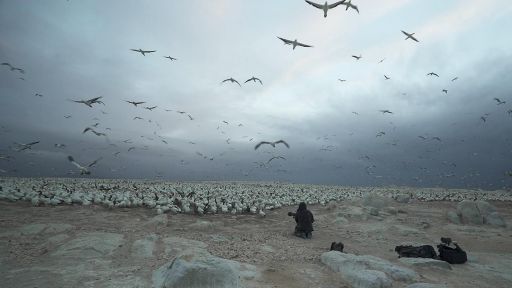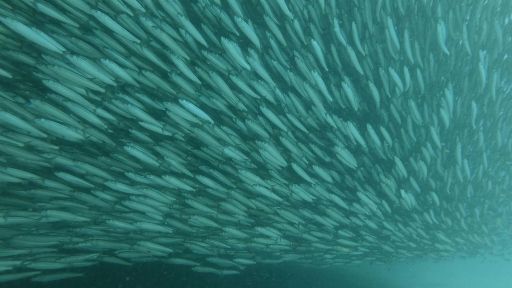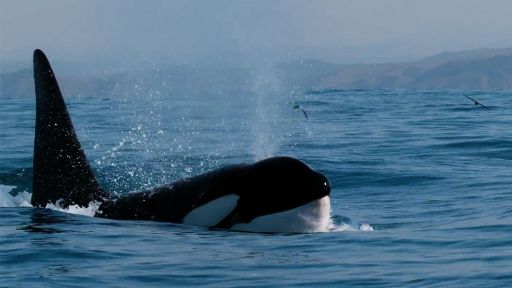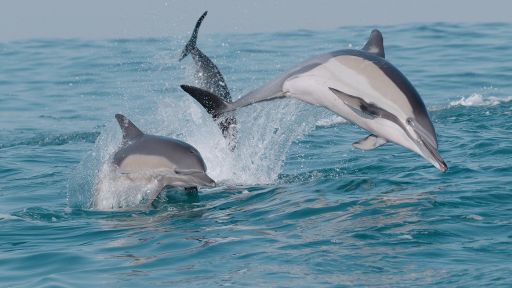TRANSCRIPT
♪♪ NARRATOR: Alone, a single fish may be insignificant.
But together, they can hold the fate of an entire coastline.
In the deep, billions of sardines begin a mass migration -- sparked by a whisper of cool water.
It's the largest movement of living things on Earth.
And it's about to become nature's greatest ambush.
♪♪ Every predator along the coast is counting on this event... ...to feast on the abundance the sardines bring... ...before they slip away into the deep.
♪♪ ♪♪ ♪♪ [ Waves crashing, wind blowing ] NARRATOR: Off the southern tip of Africa, the frigid South Atlantic mixes with the milder Indian ocean.
The waters are cold and rich with plankton, fed by upwellings from the mighty Atlantic.
Perfect conditions for a tiny fish to thrive.
♪♪ Sardines by the billions live here year-round, swimming and feeding together in loose shoals of hundreds of thousands of individuals.
Then in late April, ocean currents undergo a subtle shift.
♪♪ As the southern winter approaches, upwellings and eddies force a tendril of cold water toward the east.
The warm Agulhas Current moves further offshore, allowing the cold stream to gain momentum.
The cold-water sardines instinctively cluster in the chillier current.
♪♪ 150 miles out to sea, on the Agulhas Banks, schools begin to mass together... ...until they form a mega shoal 20 miles long.
Then the single superorganism pours into the cold-water highway toward the coast and shallower water.
It's the biggest biomass migration on the planet, exceeding the great herds of the Serengeti.
Yet, exactly why they do it remains a mystery.
The journey serves no apparent benefit to the fish.
It will inevitably dead-end in a warm sea, unsuitable for sardines.
How far they travel depends entirely on the vagaries of this year's cold current.
But one thing is certain -- an entire food web is counting on the sardines to make the run.
[ Birds squawking ] Some predators will follow the shoal for weeks.
Others wait for the feast to pass close to shore.
Some even race hundreds of miles to intercept it.
To the multitude, this year's sardine run can mean the difference between abundance and deprivation.
All are at the mercy of the current.
If the water temperature stays below 70 degrees, the sardines could travel 1,000 miles up the Eastern coast of South Africa.
But if the tendril of cold water fades, the shoals will turn, disperse, or disappear into the deep.
♪♪ The coastline waits.
♪♪ The first hazard for the fish lies just 100 miles from the sardine's home turf... ♪♪ ...a colony of some 4,000 Cape fur seals.
They're local predators, patrolling the shallows close to shore.
The pups need milk every four hours... ...so moms can't go far to hunt.
And they're reluctant to leave the safety of coastal kelp forests.
The towering plants offer protection from great white sharks.
If the seals are to feast on sardines, they need the shoals to come to them.
Mothers depend on the oily fish to fuel their milk supply.
And they're already pregnant with next year's baby... ...a precarious position when your food source is fickle.
The colony is crowded.
Pups cling to mothers.
[ Seals barking ] Tempers fray.
But this year, the sea delivers.
The cold current pushes clouds of zooplankton toward the coast and the seal colony.
The little fish follow their food... ...directly into the kelp beds.
♪♪ For the seals, it's the moment of the year.
♪♪ Their front flippers are large and incredibly powerful.
♪♪ Like paddles, they propel the seals at 15 miles per hour.
♪♪ And they provide control when maneuverability matters most.
♪♪ ♪♪ ♪♪ ♪♪ Every seal cooperates.
♪♪ The seals swallow fish whole... ...even when they're underwater.
♪♪ ♪♪ ♪♪ In the onslaught, the sardines school in an ever tighter mass.
It's a proven defense.
Every fish is equipped with a lateral line -- sensory cells in its head, trunk, and tail.
It's sensitive enough to pick up the slightest change in water pressure.
When a fish feels its neighbor move, it instantly responds in kind.
Millions of tiny, synchronized movements combine into one, forming a superorganism that shape-shifts and slips just out of reach.
The assault by thousands of hungry seals barely makes a dent in the giant shoal.
The sardines make their getaway up the coast, and the seals don't follow.
They need to get back to their hungry pups.
The shoal always stays in the cold current, covering up to 40 miles a day.
Now the females drop eggs as they move up the coast... ...prompting some to suggest that this is an annual spawning run.
Others say it's simply driven by wind and cold water.
With each mile, the water grows imperceptibly warmer.
There's no telling where or when, but the cold current will eventually dissipate.
♪♪ For now, it remains strong, impelling the fish onward.
♪♪ ♪♪ ♪♪ By early May, the sardines approach another landmark... ...400 miles east of the seal colony.
Bird Island.
[ Birds squawking ] It's the world's biggest colony of Cape gannets.
For three months, the birds have been feeding their growing chicks.
♪♪ They may be fierce ocean predators, but they're also devoted parents.
♪♪ They're monogamous, always returning to the same nest.
[ Birds squawking ] It's crowded.
That means competition for real estate... and food.
With over 200,000 birds in the colony, they need 9,000 tons of fish in one breeding season.
The gannets have pinned their entire breeding cycle on the unpredictable arrival of sardines.
♪♪ Scouts return with full bellies and good news.
The fish are coming.
♪♪ The sardine superorganism is 20 miles offshore... ...within striking distance of the colony.
♪♪ ♪♪ The birds appear awkward on the ground, even comical.
But once they achieve air speed, they are all grace and danger.
♪♪ ♪♪ ♪♪ ♪♪ They soar 100 feet in the air.
They scan the shoal with binocular vision... ♪♪ ♪♪ ...lock on to a target... ...then dive.
♪♪ Gannets hit the water at 60 miles per hour.
♪♪ Muscles lock their neck vertebrae into place.
♪♪ Airbags in the face and chest absorb impact.
♪♪ ♪♪ The sardines swim deeper to escape, but the birds' momentum carries them down... ...30 feet underwater.
If a gannet misses the target, it holds its breath and paddles, penguin-like, for a second grab.
♪♪ ♪♪ This first hunt is all for the youngsters.
Gannet parents load up their gizzards and return at high speed to Bird Island.
Every parent knows exactly where to find its chick.
♪♪ The food cargo is precious.
A healthy sardine run means more young gannets are given a chance to survive.
♪♪ But this is the fledglings' last free meal.
The parent birds will leave them forever and follow the shoals.
Any gannet that wants to eat must get on the wing and follow the fish.
♪♪ This is motivation for the chicks to fly.
♪♪ The hungrier they get, the harder they try.
♪♪ The learning curve is steep, against howling wind and rough seas.
♪♪ ♪♪ Crash-landing in the waves is their first pitfall... ...but the wild surf is not the real danger.
Fur seals hunt these shores, too.
♪♪ ♪♪ ♪♪ ♪♪ ♪♪ ♪♪ Fledglings don't have the strength or experience for a water take-off.
♪♪ Soaked feathers weigh them down.
♪♪ ♪♪ ♪♪ ♪♪ Just as the gannets exacted their toll on the sardines, the bird colony now suffers its own losses.
♪♪ ♪♪ ♪♪ ♪♪ ♪♪ ♪♪ The lucky ones must dry their feathers and try again.
They can't miss out on the first sardine hunt of their lives.
♪♪ ♪♪ ♪♪ ♪♪ ♪♪ The sardines move east at 6 miles per hour.
They're approaching the first real crux of their journey.
600 miles into the run, the coastline bends north, and the continental shelf starts to narrow.
Their cold-water ribbon is pinched against the coast by warm offshore currents.
Billions of sardines must squeeze into the cold but narrowing channel.
The shoal is stretched longer and thinner.
The fish pack tighter together.
♪♪ This current delivers them to a place called the Wild Coast.
It's a 200-mile stretch -- a pristine, untouched transition between temperate and tropical biomes.
♪♪ It's not only a mix of water temperatures, it's also a crossroads for myriad species.
It's June and humpback whales pass from Antarctica to breeding grounds farther north.
♪♪ Others live here all year round.
♪♪ ♪♪ 50 miles ahead of the shoal, resident bottlenose dolphins relish winter's arrival.
Dolphins live in social groups of about 25 members.
Their play reveals why they're such formidable hunters.
They're fast, they communicate, and they move as a unit.
A real-life sardine nemesis.
And this resident pod is just the advance guard for an even greater army.
♪♪ Common dolphins.
♪♪ They spend most of their lives in warmer waters along the coast.
This time of year, their calves are just beginning to hunt.
Mothers need to wean them before next spring's breeding season.
A glut of fish would be a crucial windfall.
♪♪ There's no guarantee the sardine run will reach them.
So they come to it.
♪♪ As they head south, hundreds of small family pods converge.
♪♪ ♪♪ A dolphin super pod begins to form, streaming to intercept the shoal.
♪♪ 100 miles to the south, the fish pour along the Wild Coast... unaware of what lies ahead.
As the narrowing current pushes them to the shallows, the shoal fragments.
Smaller, isolated bait balls offer a new opportunity... for sharks.
♪♪ These migratory blacktips and dusky sharks have moved down from the warmer waters farther north.
Little is known of their lives, but shark nurseries have been discovered nearby, suggesting that the sharks -- like other creatures along the coast -- may time their breeding cycle to the sardine run.
Tiny fish face off with dozens of sharks.
It seems an unfair match... but the sardines launch their schooling defense.
♪♪ ♪♪ As the sharks move, they send a pressure wave through the water.
The fish detect it through their sensitive lateral lines.
Just one moves out of harm's way, and every fish around it follows.
♪♪ It's incredibly effective.
♪♪ The sharks simply can't turn and bite quick enough.
♪♪ ♪♪ The predators change tactics.
♪♪ With sudden bursts of speed, they try and carve the shoal into even smaller balls... ...but they just don't coordinate enough.
♪♪ A school of 60-pound tuna gets in on the action.
♪♪ Normally the sharks hunt tuna, but they seem to know help when they see it.
The smaller tuna are much more agile.
Within seconds, they slice a bait ball from the shoal and trap it against the surface, where it's easier for everyone to feed.
♪♪ ♪♪ ♪♪ Game fish and sharks enjoy a temporary truce as they feast on the same prey.
♪♪ ♪♪ ♪♪ ♪♪ ♪♪ The main shoal flees north, leaving this fragment behind to be obliterated.
Even the gulls get their share.
♪♪ ♪♪ ♪♪ The mega shoal is now way out of its home habitat.
As long as it's cold, they swim blindly along.
They're heading toward a feature of the South African coast that will prove the most consequential milestone of their journey -- a sandstone buttress called Waterfall Bluff.
♪♪ This rocky promontory shoves the cold current eastward to collide with the warm water just offshore.
♪♪ Some years the cold water can blast beyond this point... but not this year.
The vital current thins to a trickle.
The sardines follow into the bottleneck as if spellbound.
Every single fish follows the same mission -- stick with the school and stay in the middle.
But in the fading current, the already fractured shoal breaks up even further.
Small schools follow shifting pockets of cool water into oblivion.
The great journey stalls for the fish and conditions align for every predator.
♪♪ A familiar enemy has trailed them all this way.
Some gannets will fly for 24 hours to intercept the bottleneck... and there are plenty more roosting on the nearby coast.
It's a true test for the rookies.
♪♪ The sharks are back for more, too.
Until now, the sardines have managed to slough off small bait balls as sacrificial decoys.
But now they're more vulnerable than they've ever been.
The high-flying gannets are the first to spot a stalling shoal.
♪♪ The birds stand out against the sky like a homing beacon, guiding in an army.
♪♪ It's the dolphin super pod... ...now grown to 20,000 strong.
♪♪ ♪♪ ♪♪ The sardines now face an unprecedented assault from a fleet of swift ocean-going hunters... ♪♪ ...and a far-flung deadly air force assembling above.
♪♪ ♪♪ ♪♪ ♪♪ ♪♪ The sardines turn to the only defense they know -- schooling up as tight as they can.
♪♪ One moves, and they all move.
♪♪ ♪♪ But the dolphins are prepared for this.
Their goal is to prevent the shoal from diving deep.
♪♪ They coordinate their efforts, blocking the sardines' evasion.
With surgical precision, they slice balls away from the main shoal.
♪♪ They blow bubbles to corral any fish that tries to break form... ♪♪ ...forcing the fish tighter and tighter together.
Every fish instinctively tries to get into the middle of the pack.
But now exhausted gills struggle to suck oxygen from turbulent water.
♪♪ ♪♪ Ball after ball is dissected from the shoal and obliterated.
The dolphins get what they've waited for.
♪♪ ♪♪ ♪♪ ♪♪ The toll is exponential.
♪♪ The dolphins are so effective at herding the fish that every other predator is also more successful.
♪♪ ♪♪ ♪♪ ♪♪ As the fish are driven to the surface, gannets get easy access.
♪♪ ♪♪ ♪♪ ♪♪ ♪♪ ♪♪ Dark fledglings now hunt like experts.
♪♪ ♪♪ Sharks follow and wait for the perfect moment to cash in on the tight balls.
They pick off the edges at first... ...then they plough in.
♪♪ ♪♪ The dolphins are relentless.
♪♪ Youngsters take the cue and feed on fish for the first time.
♪♪ ♪♪ ♪♪ Along miles of coastline, every predator is synchronized.
♪♪ ♪♪ Unlikely accomplices of all stripes work together toward one brutal goal.
♪♪ ♪♪ ♪♪ ♪♪ ♪♪ [ Birds squawking ] And then, with the fish exhausted and thousands of predators well fed, the biggest arrives... ♪♪ ...a 20-ton Bryde's whale.
♪♪ Thousands of sardines gone in a single gulp.
♪♪ ♪♪ ♪♪ The feast goes on for days.
♪♪ The great shoal is in tatters.
♪♪ ♪♪ It's now a 3-mile buffet.
Too confused and spent to reform their shoal, they're almost 800 miles from home.
They've been duped by the vanishing current.
Now they're lost and scattered in a strange, warm ocean... ...simply food for others.
And yet it isn't over.
♪♪ The predator of all predators arrives.
Orcas.
♪♪ As smart and cooperative as a common dolphin and three times bigger.
Orcas never used to travel for the sardine run, but now they swim thousands of miles to intercept the shoals.
♪♪ ♪♪ But it's not the sardines they're after.
♪♪ They're here to hunt dolphins.
♪♪ Not chasing anymore but running.
The orcas are not only more powerful, they have more stamina.
♪♪ Just as the dolphins corralled the fish, now the orcas work the dolphins.
They isolate one from the pod.
♪♪ ♪♪ Once they've locked onto their target, they tag-team... ...chasing it... ♪♪ ...exhausting it... then...ramming it.
♪♪ ♪♪ ♪♪ ♪♪ ♪♪ They attack again and again until the dolphin can no longer swim.
♪♪ ♪♪ ♪♪ Before they can feast, they drown it.
♪♪ The orcas have scattered the dolphin super pod.
Without the organizing force of the dolphins, the sardines regroup and slip away into deep, cold water.
The massive cloud of fish that dominated the coastline suddenly vanishes, as if absorbed by the sea.
♪♪ As July concludes, the sated hunters disperse.
Gannets proceed to travel up to 60 miles a day searching for more food.
Sharks continue their migrations, fully fed and stronger for it.
♪♪ Dolphins have successfully weaned their calves.
♪♪ Super pods thin out as family units regroup and return to their regular hunting grounds.
♪♪ The cold current has delivered the feast that all the animals were counting on.
Now it fades away, mixing with the warm Indian Ocean.
♪♪ Some believe the sardines ride the current down to secretly spawn in the deep.
Others say they follow it all the way back, 1,000 miles to their home off the Cape.
Next year the cold current will reform, stronger or weaker than the last... and billions of little fish will be driven to follow its call, to face hardship and sacrifice, toward a purpose yet unknown.
♪♪ ♪♪ ♪♪ ♪♪ ♪♪ To learn more about what you've seen on this "Nature" program, visit pbs.org.
♪♪




